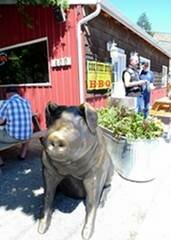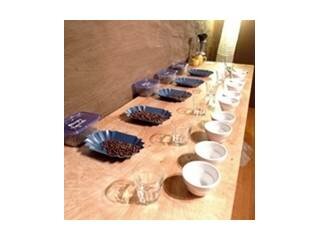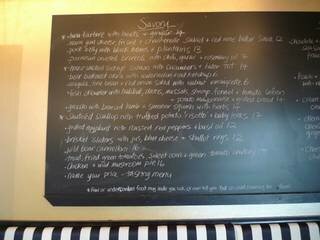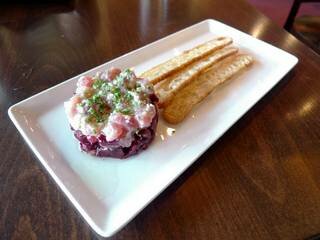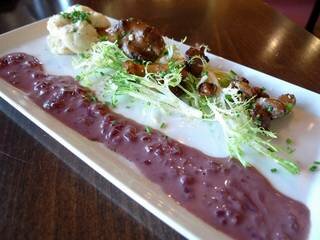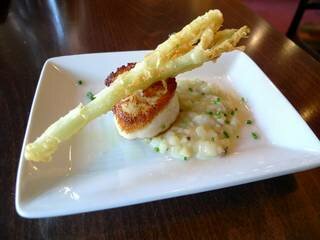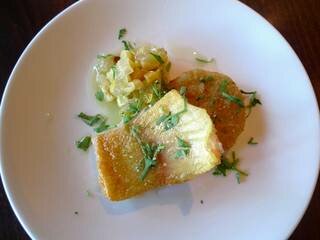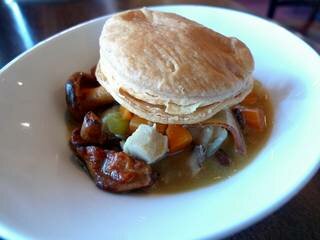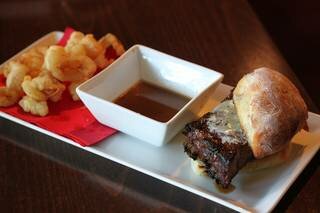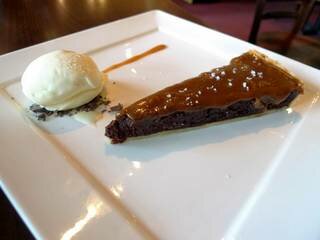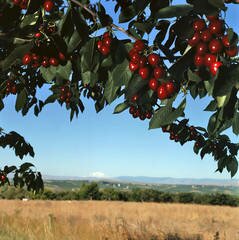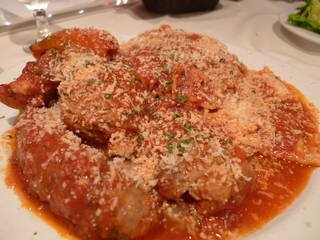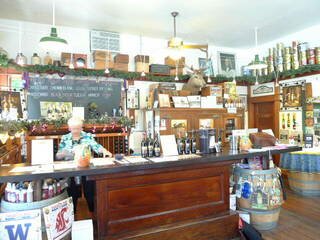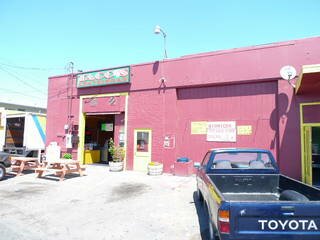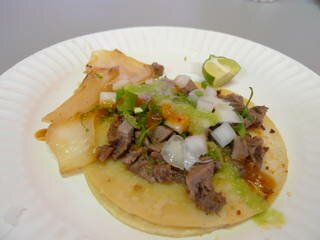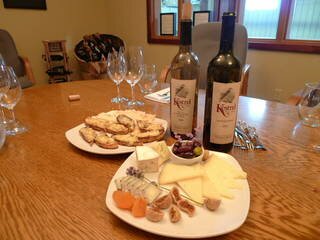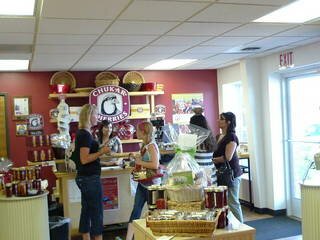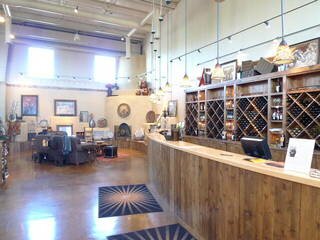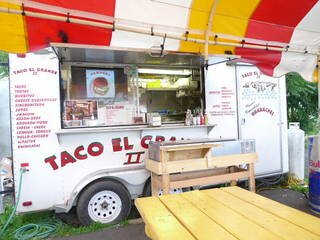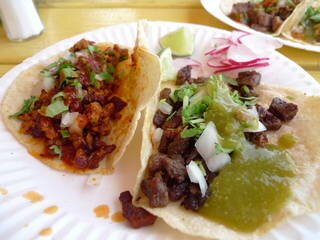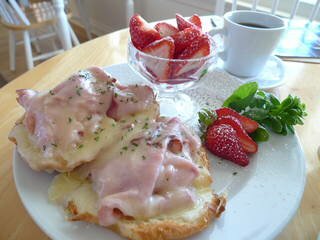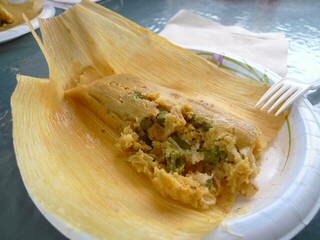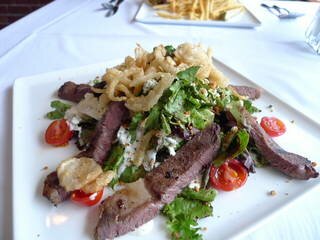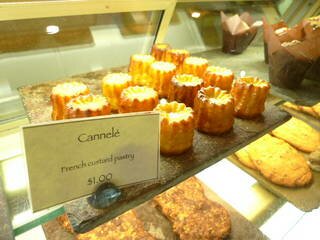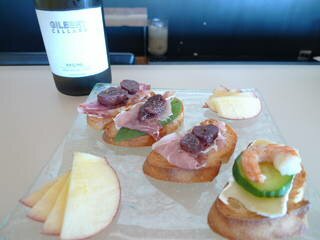Jay Friedman

About Jay Friedman:
Last Login: |
1 day ago |
Joined: |
August 02, 2010 |
Profile viewed: |
172 times |
Total Audience: |
10421 views |
Storiesby Jay Friedman |
Viewing Stories 11 - 20 of 29
|
View by List | Grid |
I didn't have the same amount of time to spend as I did in the Yakima Valley, but after an overnight at Cave B Inn at SageCliffe, a drive through the Wenatchee Valley en route to my final stop of Leavenworth gave me a few hours of agri-tourism pleasure. As it should. Wenatchee Valley takes pride in getting 300 days of sunshine, which provides a chance to produce great crops and inspiration for a great number of artisan makers.
I wanted to say a quick hello to the friendly folks at Tiny’s Organic, visiting them on their own turf after all the times I've seen them at my local farmers markets. You can do the same by making an appointment. The family-owned, friendly farm is home to lots of stone fruits (peaches, plums, nectarines, and cherries), vegetables, and, of course, apples. (I also saw some baby turkeys that will make some people very happy on Thanksgiving.)
Apples are all over Wenatchee valley, and the father and son team of Peter and Lars Ringsrud put their orchard apples to good use at Snowdrift Cider Company. They credit the hot sunny summer and cold snowy winters for producing apples with incredible aromatics, flavors, and sweetness. Snowdrift’s production began just last year; this year’s estimate is 500 cases, with an ultimate goal of 2,000-3,000 cases.
These ciders, with 8-9% alcohol content, are complex blends, with five to nine varieties of apples per blend. A little carbonation is added to enhance the flavor, as the flavor components go to the nasal passages. The ciders, which pair well with cheese and many other foods, are available at Bottleworks, Whole Foods Market, Central Market, Eat Local, and The Noble Fir.
In this land of wineries, there are some other beverages of interest. I paid a short visit to It’s Five O’Clock Somewhere (in Cashmere), where Colin Levi is enthusiastically producing Chilean-style brandy made from the wine of Washington grapes. It’s a small but fascinating operation, and the tasting room is open whenever Levi is there. Warning: The brandy is 54.7% alcohol/volume. Serious stuff. And if that’s not enough, Levi will soon be working on pear brandy and “Block and Tackle” pure corn moonshine.
Need a caffeine boost? Caffe Mela in downtown Wenatchee makes breakfast and lunch with many local ingredients, and offers hand-crafted coffee and espresso beverages made primarily with fair-trade, organic beans. The staff members are real coffee evangelists; while there, I enjoyed a chance to do some cupping, learning a lot about flavor profiles in the process. Caffe Mela also has a commitment also to the local art and music scene, offering open mike nights twice per week, and hosting weekly summer music in the park.
I didn’t have time to explore the restaurant scene. Some said that there are a few good options, while others advised me to stick to the taco trucks. In Cashmere, I did enjoy a pulled pork sandwich at Country Boys BBQ. ($6.50, and spiked with a Texas hot link for an additional $2.25.) The Boys also have baby back and spare ribs, beef brisket, and chicken, as well as the usual sides: BBQ beans, coleslaw, potato salad, and cornbread. How to find Country Boys? Amidst all the Americana strewn about town, look for a pig on the sidewalk.
If I lived in the Wenatchee Valley, I’d be visiting the Farmhouse Table Market quite frequently. It’s run by the Community Farmhouse Connection, “a grassroots, non-profit organization dedicated to supporting small farms and sustainable agriculture by bringing the community directly in contact with the farmers who grow our food.”
In addition to offering a CSA distribution program and working with local chefs and caterers, they operate the market, which features organic, locally-grown produce, farmstead cheeses, dairy products (eggs, raw milk, etc.), and other locally produced food items. It’s a friendly place with an educational focus; they’ll teach you about the products (how to use them, and there’s a library for research and recipe-hunting.
At the Farmhouse Table Market, I met Chef Richard Kitos, who, along with his wife, owns the IvyWild Inn and B&B in Wenatchee. Kitos is a colorful character in town, and a leading advocate for using local products. He suggested I pick out a few things in the market (being early summer, the morels and garlic scapes looked great) and invited me to check out IvyWild. It looked like a cozy place to stay, with a wonderful backyard for outdoor lovers, and a home theater space for indoor extremists.
But mostly I’d be in the kitchen, helping Kitos prepare a down-to-earth, omelette and salad lunch that was refreshing for a person who’d been on the road eating restaurant food for a week. In the midst of my culinary tour, a meal like this drove home the point of what an agri-tourism trip is all about.
(Note: You can also cook with Kitos. Watch the IvyWild website for various cooking class opportunities. As early as next week, there's a "Thrill of the Grill and BBQ Too" class, followed by a couple of Thanksgiving-related offerings, and then classes on tapas and cocktail party fare.)
When I heard that Jacob Wiegner, the former sous chef at Olivar, had opened a place called Blackboard Bistro in West Seattle, I had a hunch it would be good. And a desire to quickly head over for lunch.
Yes, the menu is written up on blackboards. On those blackboards, I liked the humor with which the required health department warning is delivered: “Raw or undercooked food may make you sick. Or even kill you. But so could crossing the street.” What I really liked, though, was the chance to do a tasting menu, sort of like an American omakase. You name your price, and Wiegner sends out dishes of his choosing. It’s a great value and a chance for variety; $30 buys you a feast of small plates. Figure on $5 per plate, with one plate likely to be something not found on the menu.
Note that the menu is seasonal and always subject to change. Some of the dishes I sampled recently are no longer available.
But given the consistency of the quality, that’s okay, as you’ll find new favorites. I liked everything I tasted, appreciating some bold flavors and some tastes and techniques from around the world. My only minor gripe is that I felt a bit bloated afterward; given the richness of the dishes, I think Wiegner can back off the fat just a little. (I’ve recommended Blackboard Bistro to others, who raved about their meals but had this same issue.)
My menu this day (click through the gallery above to see the photos):
- Tuna tartare with beets and ginger
- Warm goat cheese, frisée, and chanterelle salad with red wine butter sauce
- Sautéed scallop with truffled “potato” risotto and baby leeks
- Trout, fried green tomatoes, sweet corn, and green tomato chutney
- Chicken and wild mushroom pie
- Brisket slider with jus, bleu cheese, and shallot rings
- Chocolate and caramel pie with sea salt and crème fraiche ice cream
I especially enjoyed the addition of beets to what is usually a one-dimensional tuna tartare, with the ginger being a refreshing accompaniment. The trout dish offered a nice balance of the fried and fresh, while the jus made the brisket slider a fabulous French dip-like experience.
Wiegner likes to think of his place as an “American bistro.” It’s certainly set up to be a popular neighborhood joint, but based on my experience, Blackboard Bistro is worthy of being a destination restaurant.
The SageCliffe website says it best: Where the Columbia River carves through the sunny center of Washington State, there is a destination. A place where you can experience all that the land has to offer. A place where you can share a glass of wine with the winemaker, savor seasonal, regional foods, be moved by the dramatic view...
Dreamy enough?
Those words capture my first experience at SageCliffe resort exquisitely. My brief stay was like taking the best parts (potential and realized) of my three days in the Yakima Valley and rolling them into one perfect day, technically in Quincy. (You know the place: it's next to the Gorge Amphitheatre, and typically sold out--or bought out by the band--when there's a concert happening.)
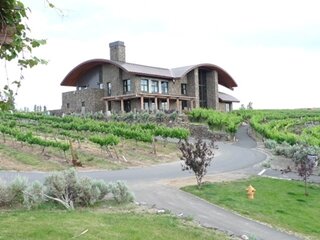 Upon approach to SageCliffe, I’m awestruck by the Columbia River Gorge, and then once on the grounds, the site of the vineyards makes me realize I’m in for a treat. Or many treats, starting with a chance to chat with Freddy Arrendondo, a former chef who brings his culinary skills into play as the winemaker for the Cave B Inn Estate Winery. Arrendondo, who is passionate about blending wines and food pairing, is fond of saying, "Wine is a food."
Upon approach to SageCliffe, I’m awestruck by the Columbia River Gorge, and then once on the grounds, the site of the vineyards makes me realize I’m in for a treat. Or many treats, starting with a chance to chat with Freddy Arrendondo, a former chef who brings his culinary skills into play as the winemaker for the Cave B Inn Estate Winery. Arrendondo, who is passionate about blending wines and food pairing, is fond of saying, "Wine is a food."
We sit in the cellar (once a unique place to hear live music--and maybe again in the future) tasting and an incredible number of wines and bantering about them. While I’m struck by talk of the return of the rosés, which Arrendondo says pair well with the smokiness and sweetness of grilled food, my favorite is the 2006 Merlot--so much so that in an unusual twist, that wine will dictate my dinner choice, and not vice-versa.
But not before checking into my home for the night. Perched on 900-foot basalt cliffs (this material features prominently in the make of the buildings), Cave B Inn has 30 rooms, half of which are Cliffehouses like the one in which I’m staying. My room is spacious, with high ceilings and enough glass for exposure to natural light, but also the right amount of privacy.
(At the time of my visit, the Chiwana Village was just being completed, so I didn’t get a close look at the yurts. But if you think that you’d be roughing it, note that the 25 yurts feature king-size beds, roof sky domes, private baths, iPod docking stations, and wifi connectivity.)
There’s much to do here, from hiking to biking, boating down the river to swimming in the Cliffside swimming pool, rock-climbing and more. But this outdoor non-extremist, slowed some by wine, is ready to relax. I’m not sure which is more compelling: the chairs on my arbor-covered terrace with its panoramic view of the gorge and the coming sunset, or the comfortable couch in front of the fireplace (which is actually a two-sider, also facing the bedroom).
Soon, though, it’s time for dinner, which means a short walk to the main lodge where Tendrils Vineyard Restaurant is located. Remember that merlot? I do, meaning the lamb will be my choice, and a perfect match for the wine. My companion skips the entrées and opts for an array of smaller plates, as she loves variety.
The dishes (a few extra make their way to our table) are delightful, generally well-prepared and delicious. I’m tired of the confit craze, but duck confit beefs up some fennel-leek soup; even better is the grapevine-smoked Columbia River steelhead that I sample.
Other favorites:
Asparagus with hazelnuts, watercress, shaved fennel, and cabernet vinaigrette equals the taste of summer.
Warm lobster with brandy cream and lemon popover--fun presentation.
Seared scallops with pea shoots, angel hair pasta, herbs, and saffron butter--wonderful!
Roasted carrot raviolis with fried carrot chips, shallot-tarragon creme fraiche, and snap peas--pillows of pleasure.
Spice-crusted Washington lamb loin with carrots, wilted greens, and sweet potato hash--the perfect pairing for my merlot.
We enjoy dinner inside, but as it’s an absolutely gorgeous evening, we move to the deck to enjoy dessert, a cheese plate (including some prime picks from Monteillet Farms), and coffee while watching the sunset. (In the photo to the right, my Cliffehouse is taller of the buildings, on the right.)
Chef Joe Ritchie steps outside to chat with us for a while. A former sous chef at the Herbfarm, he raves about the slower pace of life in the area, the opportunity to get to know local suppliers, the joy of having the garden right outside the restaurant, and the challenges of the changing weather. But it turns out that change is in store for him, as he recently returned to Seattle and is currently working at Poppy.
(SageCliffe is currently seeking someone to replace Ritchie, but the kitchen is still active--and you can be part of it. Chef Weekends offer hands-on workshops with wine and food. In fact, Ethan Stowell is on the program later this month, followed by John Howie early winter.)
The next morning, as comfortable as the room is, I wake early to take advantage of the morning light, and take a stroll on Steep Trail to the Columbia River Trail. It’s a little steep at the start, but very manageable, and both gorgeous and inspirational. I stop so often to enjoy the view that time starts running short (and my stomach starts rumbling); I don’t make it to the rocky beach, but that leaves the trek as something to do another time.
Appetite again intact, it’s time for breakfast, and one last chance to sit outside and enjoy the landscape. I survey the mountains to the northwest and start imagining my upcoming days in the Wenatchee Valley and Leavenworth, but return to the moment and revel in the time spent here. My companion proclaims Cave B Inn, along with the Inn at Langley, as her favorite getaway destinations in the Seattle area.
Sad to leave, we talk about returning someday to see the view again and maybe check out the on-site spa. I initially think it’s too far, but then remember the words of Arrendondo, himself a bit of a world traveler. "Get over the driving and get over to Cave B," he admonishes, "Especially for crush." (Check out the happenings for Harvest Festival.) At just over two hours from Seattle, the drive is the perfect amount of time to reach SageCliffe, which bills itself suitably as "a place of serenity and stunning panoramas."
(Note: Cliffehouse interior and Tendrils interior shots courtesy of Yanmei Shi.)
After Ivar's sent some samples of tartar sauce and cocktail sauce, my partner and I decided to speed over to the seafood section to prepare food for sauce tasting.
First up was fish, sans chips. Fresh, wild-caught cod deep-fried with a panko coating would be the perfect way to test the tartar sauce. My partner dove in as I readied a lemon squeeze, and she quickly screamed out a warning: "No lemon, no lemon."
Turns out this was a new Zesty Lemon Tartar Sauce, already packed with enough citrus punch. More disconcerting, though, is that it was missing enough of the cucumbers, capers, or other relish-like elements that I crave in adding texture to tartar sauce. Plus, it lacked bite that horseradish would provide. This tasted more like a lemony mayonnaise.
King crab would be a simple way to sample the cocktail sauce, which I soon realized was the new Spicy Ginger Lime Cocktail Sauce. The ginger was prominent and interesting, though not necessary for me. Lime makes sense, and luckily was less prominent than the lemon was in the tartar sauce. As for spicy, that simply wasn't happening.
Both the tartar sauce and the cocktail sauce would benefit from a bit more horseradish. In fact, after seeing that water and high fructose corn syrup (HFCS) are the two leading ingredients in the cocktail sauce, I'd recommend making your own (which would likely mean making your own ketchup, unless you find one without corn sugar HFCS). Note that the "Original Recipe" cocktail sauce doesn't designate its corn syrup as high fructose (you can ponder that), but it does contain MSG, if that's a concern for you.
Ivar's is a Seattle institution, much-beloved for many valid reasons. These two sauces serve as a reminder for me to eat more seafood, but also remind me that I prefer to personally prepare the foods that are normally found in the inside aisles of a supermarket.
In previous culinary Escapes from Seattle, you've seen what happens when a food-loving indoor extremist goes to Whistler, and just last week, for the start of a new trip report, you learned how the Portland food scene differs from Seattle's. That trip next took me from food-rich Portland to the wine-rich Yakima Valley. Would I go hungry, and be forced to live on wine (and cherries) alone?
Perhaps the most prominent restaurants in Yakima are Tony’s Steakhouse and Gasperetti's Italian restaurant. I checked them both out, and found them to be ordinary places that could be in Anytown, USA. Tony's featured big plates with big portions and big protein boosts for lunch, such as an American Kobe (does that really mean anything?) prime rib salad.
Meanwhile, Gasperetti's was a tomato-sauce type of Italian restaurant where I sampled "John’s Combination Plate," with spaghettini, ravioli, Italian sausage and meatball, chicken cacciatora and chicken giblets. Points to Gasperetti's for offering some seasonal asparagus dishes, though points deducted for a "G-Spot" lounge that wasn't all that stimulating.
If it's asparagus you want, and you're hitting it in the right season (May until perhaps the last week of June, when I got there), check out Los Hernandez in Union Gap. They sell tamales, handmade fresh daily; the friendly shopkeeper told me that people trek from Bellingham to Boise to buy them by the dozen, usually frozen. I got there late afternoon my first full day in Yakima only to be told that the asparagus tamales were sold out, so I made it a point to go again early the next day to be sure to sample them. (They also have chicken and the more traditional pork varieties.)
The wait was well worth it. The tamales come out steaming hot and packed full of asparagus flavor, making Los Hernandez a unique food find. Los Hernandez also offers own fresh-made salsa, homemade masa (they cook and grind their own corn to make a more preferred coarser texture) and hojas (corn husks) in bags of 120.
Some of my favorite meals were at the many taco trucks and shops you'll find as you drive through the area. In Yakima, I enjoyed some soft-shelled specialties at Taco El Grande, which is across the street from Fiesta Foods grocery store—the Uwajimaya of the Mexican variety. At Fiesta Foods, it's fun to wander the aisles to see the different meats (look for lots of tripe and tongue), produce (avocados and jalapenos abound), beans, the aforementioned masa and hojas, and fresh juices available.
In Sunnyside, I ate more tacos (with a side of caramelized onions) at Tacos Apatzingan, a small taco shop in a garage—in fact, it's attached to an auto garage. This was part one of a two-part lunch, the other at Snipes Mountain Brewery, which uses local hops to produce a variety of beer varieties, including E.S.B. (Extra Special Bitter). While it was nice to see the glass-enclosed brew room inside the restaurant, had I thought about it, I would have gotten a growler to go and had it with those tacos at Apatzingan.
Beer makes a nice break from all the wine-drinking for which the area is known. Another colorful option is the Yakima Sports Center, which features fresh fruit drinks (of the alcohol variety) and a varied menu from gnocchi to green curry, and burgers to beer-battered fish. You'll know the place from the huge, revolving hunter hanging on the outside of the building and all the Yakima Sun Kings memorabilia on the inside.
One winery offering a non-alcoholic alternative is Piety Flats Winery, which does old-fashioned root beer floats. But it is a winery, with a welcoming counter that invites the pious and non-pious alike. Piety Flats resides in the historic Donald Mercantile building, dating back to 1911, and true to the name it carries local gourmet specialty products perfect for picnicking, including Cougar Gold cheese from WSU.
I hit a few other wineries with food offerings, such as Gilbert Cellars in downtown Yakima. Gilbert’s counter (handmade, as are other wood features that give the place a classic-yet-contemporary, wine bar feeling) is a perfect spot to sample tapas with wine pairings to match. Also downtown is Kana Winery's tasting room, a little more traditional feeling, selling some food products of local interest, as well as creamy truffles made by Brigittine Monastery monks. Further from Yakima, Windy Point Vineyards offers cooking classes, and also inviting chairs to sip and sup while taking in the rolling landscape. (The terrain of central and eastern Washington is simply terrific to behold.)
But my favorite food experience at a winery was at Kestrel Vintners further east in Prosser, where Carlos Trevino offers the most interesting opportunities to explore food and wine pairing. Come to Kestrel on a Friday evening, and you might get to join a Simple Supper (with a main, side and glass of wine for $15), or, if not the third Friday of the month, then experience Bites and Flights, as he prepared for me. It's a wonderful opportunity to not just speculate about pairings, but to actually experience and discuss them with some of Kestrel's winemaking team.
My stay in Prosser was too brief. I was camped out at White House in Yakima, which is probably better known as a café serving breakfast and lunch daily than as a B&B. If a room with wide-eyed baby dolls, multiple pairs of baby shoes, random wedding photos, and ornamental plates on the wall (and a bathroom with seven wall mirrors, 16 hand mirrors, and four clocks all reading 12:12) holds charm for you, then this is your place to stay.
I wish I had taken a night at Desert Wind Winery in Prosser, offering gorgeous rooms with balconies overlooking the Yakima River and featuring fireplaces, large tiled baths, plasma TVs, and tasteful Southwestern decor. Desert Wind offers a fine selection of wines, and on-site is Mojave by Picazo for select meals. (I’ve heard good things about Picazo 7Seventeen Wine Bar & Restaurant in town.)
Nearby is the Prosser home store of Chukar Cherry Company. Most Seattleites know the sampling station and store at Pike Place Market, but the Prosser location offers more personalized service, more products and tastings, a chance to learn more about the process of making the cherry delicacies. Those products include peach cherry salsa, curried cherry chutney, and cherry chipotle BBQ sauce, as well as a vast array of chocolate-covered cherries. (Perhaps it was the influence of wine country, but I liked the cabernet cherry and pinot noir cherry, though my favorite was chipotle cherry for its slight smokiness and spicy finish.)
Cherries are, of course, are prevalent in the area, as Washington state produces more than half of the sweet cherries grown in the country. My final morning in Yakima, I paid a visit to the Washington Fruit Place and Gift Shop at Barrett Orchards, which produces a wide variety of fruit. This fourth generation orchard is a wonderful place for peeking (there's a self-guided information tour), picking, and picnicking—or just shopping at the store. (Another non-wine alternative are the fruit smoothies they sell.)
Beware that it's hot in the desert if you go during summer harvest months, so seek shade for rest. I took a bag of cherries for the road and made a final stop at Essencia Artisan Bakery and Chocolatier for tea of the iced kind (and some sweets as well), bidding farewell to the Yakima Valley as I headed north, as I'll describe in the next report.
The utilitarian Haas avocado is frequently on sale in these parts, and while I often simply cut slices into a salad or mash one to make guacamole, Mark Bittman's recipe for "Fast Avocado Soup" recently caught my eye.
This is simple soup. Take a few avocados, combine with an almost an equal number of cups of milk, then blend with some salt and cayenne. Chill (yourself, and the soup) for a few hours, then add some citrus to taste. (I didn't care for orange juice, but lemon or lime is fine.) Per the recipe's suggestion, I can see adding chopped cherry tomatoes and/or thinly sliced green onions, but I went the full upgrade by tossing in some cooked crabmeat with a lemon squeeze.
Good payback for your quick investment. I love the color and the creamy texture. But the soup reminded me of two cold concoctions that I like even better: avocado ice cream (from David Lebowitz's The Perfect Scoop) and avocado bubble tea with chocolate. Still, soup is more of a meal, isn't it?
Today may be the last day of summer, but fall is a fine season for taking culinary-related trips outside of Seattle. Having previously reported on an "Escape from Seattle" to Whistler, it's now time to head south to Portland and then loop up through parts of central Washington to discover good eats (and drinks), as I did this past summer.
Let's start with Portland. You're probably thinking: Oh, not another article about how Portland's food is better than Seattle's. Maybe not better, but different. And when traveling, aren’t we usually looking for something different? I'll offer a few examples, but by no means an exhaustive list.
Portland's got a different food vibe than Seattle. As local food writer Lorna Yee recently remarked about Portland in a SunBreak interview, "the food is a little gutsier, and the scene a little grittier."
The dining spaces are certainly different. It seems Portland chefs and restaurateurs are more creative with their kitchens and dining rooms, as you can eat at carts, strip clubs, and converted industrial spaces. There's the usual glitz and glamor of downtown eateries, but in general, I find the better eats to be on the east side of the Willamette River. (Even if you take the train to Portland—a fun way to travel—you can easily head east by bus and foot. I've done it, and you get to discover more of the city this way.)
What better place to start than breakfast? If you're tired of the typical menus full of eggs Benedict and the like, I recommend Tasty n Sons—the new hot spot from John Gorham of Toro Bravo fame.
As always, I like to sidle up to a seat at the counter and watch the cooks do their thing in the open kitchen. They do breakfast daily, and have just started serving up dinner service, too.
Asian food fan that I am, the Burmese red pork stew (with eggs two ways) was right up my alley. A hearty, heavenly breakfast.
If it's eggs you ache for, the much-heralded shakshuka (red pepper and tomato stew with baked eggs, plus our addition of merguez sausage—recipe here) was also delicious with bright flavor, and radicchio salad was a perfect, crunchy counter to both dishes. And how could I resist a chocolate potato doughnut as a last bite?
(As alternative breakfast picks, I recommend aebleskivers at Broder, or soup at HA+VL, further east, which unlike anything in Seattle, prepares a different Vietnamese soup—or two—every day of the week.)
Also east is the ever-popular Pok Pok. I continually complain that Thai food in Seattle is too uniform in its offerings. Pok Pok is proof that a more diverse menu can amaze the masses. With its indoor and outdoor seating, and cooking areas scattered about the place when the grills are going, eating at Pok Pok feels like a visit to Thailand. This is definitely a place to go to with a group to experience as much of the menu as possible.
Pok Pok was one of my top picks during my feeding frenzy in Portland last summer. A group of us enjoyed dishes like crispy broken crepe with mussels, eggs, garlic chives and bean sprouts (hoi thawt), and boar collar meat rubbed with garlic, coriander root and black pepper, glazed with soy and sugar, grilled and served with chilled mustard greens and chili-lime-garlic sauce (muu paa kham waan).
The food quality slipped during this summer's feeding frenzy, but maybe it was an off-night? I'll want to give it another chance, but at least Ike's Vietnamese fish sauce wings remained a winning dish. Best thing is that if you don't want to wait it out an hour or longer at Pok Pok (I told you the restaurant's popular!), you can also go to the Whiskey Soda Lounge (recently relocated across the street).
There, enjoy an easy chance to have an order of those wings, perhaps as I did along with other interesting street food like fresh tamarind pods (makham waan, with chile salt and sugar dip) and a Pok Pok Bloody Mary (with Thai chilies and aromatics pounded in a mortar and pestle). And if dining solo, you can enjoy those wings without having to worry about sharing with others.
Should you prefer to stay in the downtown area, Nong's Khao Man Gai is a food cart that's an offspring of Pok Pok. (Nong worked at Pok Pok prior to opening her place.) To say that chicken is also the best dish here will ultimately prove obvious, as chicken and rice is the only dish Nong makes. Nong's epitomizes what a food cart business should be: specialization.
While most of Seattle's food trucks have been, at least at the start, spins on typical “fast foods” like hot dogs and pizza and tacos (even our Thai truck serves up the same old pad Thai), Portland's carts, found clustered in pods, branch out with special and unique offerings. Oatmeal? Check. Fried pie? Check. Bosnian food? Check.
Nong's is a great concept with well-executed food. The chicken is surprisingly moist, and the rice, cooked in broth, is flavorful. Customization is basically limited to a side of livers or a side of fried skins (which I liked better). And while the food isn’t quite as bold as I typically crave, I appreciate quality, and would recommend Nong's to anyone. But go early. Nong's is only open until she sells out, which is usually early afternoon, making this a prime lunch pick.
For dinner, I recommend Tanuki, in the Nob Hill district. This past summer trip, as with the previous, Tanuki came in as one of my top three favorite meals. Or is it a drinking experience? Chef Janis Martin will tell you that Tanuki is a bar, not a restaurant. (Tanuki is truly an izakaya.) This woman knows sake, so let her choose some pairings for you.
And, by the way, let her choose your food. Just say "omakase" and you're in for an amazing and affordable ride. (IF one were to see the kitchen, one would be astounded at the quality of the food that comes out of it.
Let's just say that Martin makes magic back there.) The food is bold; there might be a moment of "hmm, that didn't quite work," but nearly all of it does, with impressive flavor combinations. I can best describe it as Japanese food with Korean and southeast Asian twists, such as oysters with kimchi shaved ice, a beautifully boxed mushroom and duck salad, halibut cheeks with braised pig tail, and wild boar steamed rice dumplings ("rags").
Note that this is unconventional food coming from an unconventional chef (priding herself on being politically incorrect) in an unconventional setting. A sign at the entry says "No sushi, no kids," and the Japanese slasher porn-like flicks on the television can be a bit distracting. (Okay, I admit: They’re captivating in a fun, albeit disturbing way.) But the food is memorable, made special by Martin who, politics aside, works hard, plays hard, and takes pride in her product.
How about one more pick—a wild card? Looking at my eating itinerary, I would have never guessed that lunch at Fenouil would be one of the best meals of the summer trip. With my love of big, bold flavors, I was surprised to find myself appreciating the subtlety of Fenouil's food – but that's the point of the experience.
All of the dishes were executed perfectly. The succotash sang spring (my trip was actually at the very start of summer), the fries were captivatingly crisp, and the risotto creamy with the peas prominent. And a dish I'd never think of ordering, especially with an understated title of "Roasted Natural Chicken," was a highlight. This was the moistest white meat I’ve ever eaten, and the skin was expertly crisped, with the acidity of the artichokes and olives playing perfectly in the dish.
Finally, at Fenouil, I found a pastry chef doing fantastic finishes. Black pepper cheesecake was the best bite of the entire Portland trip, and of all my eating experiences in recent memory. Upon request, Kristen Murray sent out a list of ingredients that blew my mind, making me realize how she achieved the wonderful taste and texture of the dessert. These included sweet pea blossoms, thyme, wild rose petals, three kinds of mint (apple, pepper, and chocolate), lemon balm, and candied fennel--savory elements that contributed to a sweet ending of this amazing meal.
Murray also invited me back for a dessert tasting two days later, which further impressed me. Enough to say that I liked her desserts better than any I've had here in Seattle. But following the big surprise came big news: Murray recently left Fenouil. Status in doubt, she just resurfaced at Paley's Place.
A proper excuse to soon make another trip to Portland....
Okay, time to close out this inadvertent "noodle trilogy" with a confession of sorts: I did not prepare the yakisoba or the hiyashi udon discussed the past two weeks. And I certainly wouldn't want to claim preparation of the "girl noodles" in this week's "Something I Ate." The better half is from Japan. She's the mistress of Japanese noodles in my house, and she asked that I set the record straight.
Not that there's anything wrong with "girl noodles."
That's not the real name of the dish--it's something sorta sexist I made up because noodle dishes like this are especially popular with women in Japan. Or so I'm told.
The "girl noodle" dish actually comes close to something called "salada udon," which is basically salad over cold noodles. Udon is great to use, but in the summer, we she likes to use somen noodles.
Being a busy week, the noodle dish pictured (which will get me in trouble, as it's rather unsophisticated) is a very basic version with ham, lettuce, sliced cucumber, and Japanese mayonnaise. The dressing can be tsuyu sauce, or an improvisation of soy sauce, mirin, sesame oil, lemon, and/or whatever else you like. Additional toppings like shiso, avocado, nori, and maybe even tuna or tomatoes can spice up your "girl noodles."
And at the risk of getting in even more trouble, may I suggest that pork belly would help turn them into "boy noodles"?
If pre-Labor Day is serious summer and the season for cold noodles, then post-Labor Day is faux fall—and a perfect time for hot noodles.
Few noodle dishes are better than yakisoba, which literally means "fried noodles." It's a Japanese dish derived from China and made not from buckwheat ("soba"), but from ramen-like noodles made with wheat flour.
There are some variations of the recipe, but in my home, we fry the noodles with bite-sized pieces of pork, along with some thinly sliced carrots, cabbage, and onion. You can add dashi (fish stock) not just for flavoring, but to help keep the noodles from sticking together.
As with many of the "yaki" dishes (like okonomiyaki and takoyaki), top the fried noodles with aonori (dried seaweed flake) and katsuoboshi (dried tuna flakes), which dance when they hit a hot surface. You can also add beni shoga (red pickled ginger) and some Japanese mayonnaise if you like.
But be sure to include usuta sosu. Sound it out, and you'll know it refers to Worcestershire sauce. It's not quite as thin as Worcestershire, but thinner than the more-readily available tonkotsu sauce, which you can also use if nothing else is available.
We usually eat yakisoba as an entrée, but you can also have it as a side dish. Or you make yakisoba-pan, piling your cooked noodles into a hot dog bun, then garnishing it with mayonnaise and pickled ginger. Any way you like it, this is Japanese street food done at home. Quick to make, quick to eat, and beloved by people of all ages.
Just as ma po dou fu is a favorite emergency dinner option in my home (even if there’s no ground pork in the fridge, there tends to be tofu in there, and there’s always frozen pork in the freezer), udon is ubiquitous for lunch when we’re otherwise uninspired. We do a number of noodle dishes that go beyond udon, including dan dan noodles, somen (only in summer), Phad Thai, and yakisoba, but “something udon” is generally quick and easy.
I usually prefer frozen Sanuki udon for its texture (a thicker, stiffer variety from Kanagawa prefecture), so we stock up whenever there’s a sale at Uwajimaya—with noodle packages taking over the freezer.
I like the versatility of having udon either cold or warm—in soup or not. Most often, we have kitsune udon, with the noodles served in hot dashi along aburaage (a deep-fried tofu pouch) and kamaboko fish cake. When I make a batch of kimchi (which we’ll keep forever in the fridge, letting it get more and more pungent), then it’s definitely kimchi udon time for fermented fun.
But with the Sous Vide Supreme at our disposal, my partner pounced on the chance to enjoy what’s essentially the onsen tamago from her homeland. In Japan, the eggs cook slowly in a bubbling, sulfuric (an onsen is a hot spring) bath, leaving them half-cooked with a runny yolk—and perfect with rice and other savory accompaniments (like seaweed or dried fish) for breakfast. We don’t have a hot spring handy, but I believe that eggs are one of the best foods to prepare sous vide. Just 45-60 minutes in a 148 degree water bath, and the eggs have a perfect texture.
For hiyashi udon, cook the noodles until done, and then rinse under cold water and shake dry. Add grated ginger and thinly sliced green onion to your liking, along with tenkasu (dried tempura bits) and tsuyu (dipping sauce). As at an udon restaurant in Japan, you can add a variety of other topics. Our choice: that onsen-like tamago, with the runny yolk coating the noodles in eggy goodness.
 Previous
Previous
